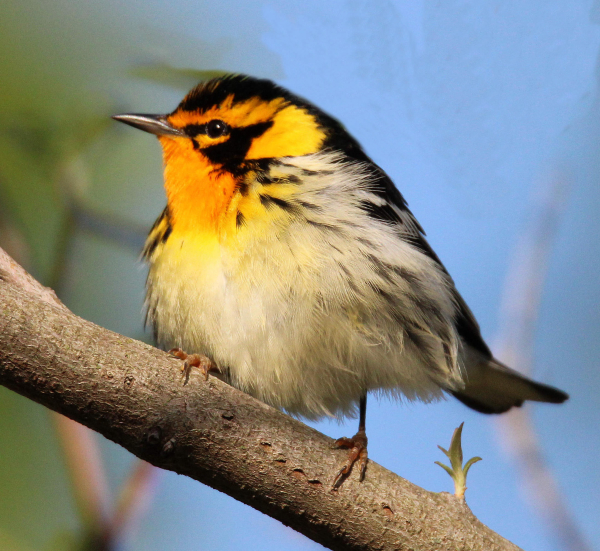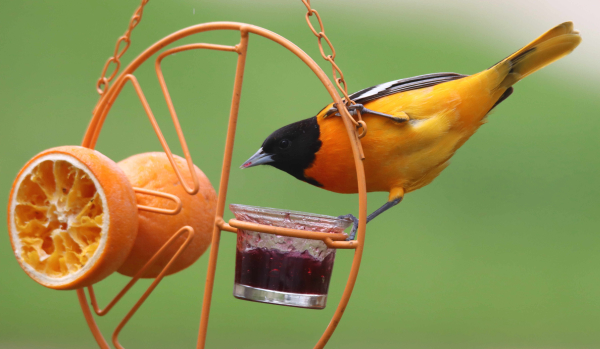
In the case of some birds, like this striking Blackburnian Warbler, we may only get a few glimpses of some exciting migrants, but others will spend days and weeks within sight (photos by Paul Konrad).

Be sure to provide grape jelly with the usual cut oranges to attract orioles to your feeding station. With a dependable source of food and water available, some orioles may be enticed to stay to nest in your area.

When hummingbirds crowd a feeder, or when one individual becomes overly territorial, it can be a good idea to add a second hummingbird feeder out of sight, around a corner for example.
|
Is your yard ready to host migrating birds this spring? The peak of migration is just a few weeks away now, which means we need to take advantage of coming days when the warmth of the sun provides time to prepare for the advent of migrating songbirds, many returning from wintering ranges in Central and South America. This includes some of our favorite “backyard birds” including orioles, hummingbirds, warblers, thrashers, catbirds, and more. The time to watch for these long-distance migrants is drawing near, so let’s make our yards as inviting and beneficial as possible.
The spring migration period may be the time of the year that birds most need the kinds of resources that we birders provide. Weary migrants will be pressing north to establish territories, mate, nest, and raise young. But in preparation for new species to arrive, it may also require a switch to different foods, feeders, water features, and landscaping strategies.
Fresh Water – All birds need water to drink, to bathe, to help maintain their plumage. Providing fresh water daily is the easiest and most economic way to attract the greatest variety of birds. Keep your birdbath or other water features filled with an inch or less of water so small birds can easily bathe and drink too. Keep that in mind when you are shopping for a birdbath or basin too – to best serve a variety of birds, you don’t want a deep-dish basin. Migrating birds that are unfamiliar with a location listen for the sound of moving water, so a water drip, mini-fountain, or water wiggler can be helpful to attract warblers and other migrating songbirds.
Seeds – Make an extra effort to keep your feeders filled and clean. Provide quality seeds that include black oil sunflower seeds to attract the greatest variety of seed-eating birds, some thistle seeds especially for finches, and maybe some peanut pieces to attract woodpeckers, jays, and nuthatches as they pass through or arrive for the nesting season.
Suet – Suet should be a year-round option at your feeding station, and as temperatures warm a no-melt variety of suet will become all the more valuable and easier for you to handle.
Grape Jelly & Orange Halves – Provided especially for orioles, cut oranges add an initial attraction for migrating orioles that stop, but you will likely see that the orioles prefer grape jelly, right out of the jar. Orioles are attracted to orange color and seem to eat more during migration than any other time, so it’s always worthwhile to have some cut oranges to alert them to your feeding station, but the grape jelly will keep them coming back. And if you are lucky, you may be able to entice some of the orioles to stay in your yard or immediate neighborhood to nest and raise their nestlings to fledging. We are convinced that we short-stop some pairs of orioles each spring that would keep flying north if we didn’t provide such dependable and delectable foods to add to their insect diet. Other birds will also utilize the orange fruit and grape jelly offered at an oriole feeder; possibly catbirds, robins, some warblers, some tanagers, House Finches, and others.
Hummingbird Nectar – Hummingbirds can be expected about the same time orioles arrive, and it’s best to have fresh sugar-water nectar in your hummingbird feeder before you see the first hummingbird. If you mix your own nectar, the prescribed mix is 1 part white sugar to 4 parts water, which is similar to the sugar ratio found in flower nectar. As with orioles, your dependable food source may entice some hummingbirds to stay in your area to nest.
Oriole Nectar – Some orioles also like sugar-water nectar, so you can offer the same 1-to-4 mixture in a specialized oriole feeder that has larger holes in the feeding ports than those provided in a hummingbird feeder. They also tend to have some orange color to attract orioles. Be aware though, that at our feeding station, the Baltimore and Orchard Orioles that feed on oranges and grape jelly ignore the oriole nectar feeder; but you never know how birds in your area will react until you try.
Hummingbird Flowers – Even though you provide a steady diet of fresh hummingbird nectar in a feeder, you can provide a selection of red tubular flowers for hummingbirds too. To have an abundance of blooms by the time hummingbirds arrive in your area, you may need to rely on your local greenhouse, which should have some already flowering plants on hand for you to add to your yard – either in a garden bed or in pots that you can position wherever you want, including near your feeding station. Red is the best color for hummingbird flowers because they produce nectar with the highest sugar content, but you can always mix in some yellow and orange tubular flowers that produce nectar with a little less sugar content that will still be very attractive to hummingbirds.
Landscaping – Any trees, bushes, vines, flowers, and grasses combine to create bird habitat in the form of shelter, roosting areas, nesting sites, and foraging areas. Any vegetation is likely to attract insects that will attract a variety of migrating songbirds including warblers, vireos, thrushes, tanagers, grosbeaks, waxwings, finches, towhees, native sparrows, and orioles, as well as hummingbirds, flycatchers, kingbirds, and swallows. Any trees, bushes, or vines that produce fruits or berries add all the more attraction for birds, and it’s always worthwhile to think ahead to consider planting these kinds of landscaping elements for birds to utilize during future spring migrations. We provided an expanded article about birdscaping in last week’s issue, which you can also access at Birdscaping Your Yard, One Corner at a Time | Birding Wire
Nest Boxes – It’s also getting close to the end of the period to add new nest boxes to your property to benefit cavity nesting birds that are looking for a place to nest. We like to add 1 or 2 new nest boxes each spring to add to any woodpecker-created cavities or natural cavities. We also published an expanded article about bird houses and nest boxes in the February 21st issue, which you can access at Selecting the Right Nest Boxes | Birding Wire
You may consider your yard to be a small drop in the bucket to benefit birds, but considering that 90 million Americans and millions of Canadians feed birds and provide water, while millions of other ‘non-birders’ who garden and landscape their yards in ways that provide added habitat coincidentally, there are rivers of drops in the bucket, all of which make a difference to some individual birds, and to many species overall across the continent. Together we can provide more habitat and better habitat and food resources each year.
While Latin America has nurtured neotropical migrant bird species over the winter, it’s clearly time for us to do our part while enjoying the bird diversity and excitement of new birds visiting our yards and lives during spring migration and into the nesting season. It’s all great fun; enjoy this spring season!
Share your backyard birding experiences and photographs with The Birding Wire at editorstbw2@gmail.com